Spatial and Temporal Distribution of Multiple Cropping Indices in the North China Plain Using a Long Remote Sensing Data Time Series
Abstract
:1. Introduction
2. Material and Methods
2.1. Study Region
2.2. Data
2.3. Methods
2.3.1. Spatial Sampling and Extracting LAI Time Series Information
2.3.2. Filtering and Reconstructing LAI Curves
2.3.3. Extracting MCIs
- (A)
- The time positions of peaks in the LAI curves of dry land appeared from 120 to 300 day of a year;
- (B)
- The LAI value in the peaks could not be less than two under the single-peaked curve;
- (C)
- The time differences between peaks could not be less than 40 days when multimodal peaks appeared in a LAI time series curve; in addition, the LAI value of the smaller peak could not be less than 40% of the maximum peak value.
2.3.4. Mapping MCIs
2.3.5. Validation Analysis
3. Results
3.1. Temporal and Spatial Changes of MCI in the North China Plain
3.2. Comparison Analysis
3.2.1. Statistical Comparison
3.2.2. Comparison with the Other Remote Sensing Monitoring Results
4. Discussion
- (1)
- Compared with other vegetation index products (such as NDVI and EVI), the GLASS LAI product has a great advantage in this study. This LAI product has remarkable advantages related to the integrity of the spatial scope and continuity of time series. For example, cloud and snow spots on the images were removed, missing values were extrapolated, and the images were processed by optimized filters (see Section 2.2). Although EVI is currently a commonly used fine vegetation index, the high quality EVI product could not be obtained until 2000; therefore, it was not suitable for our research [56,57]. However, long time series NDVI products were easily obtained, e.g., AVHRR NDVI (1981–2006) and the MODIS NDVI (since 2000) dataset; nevertheless, these require elaborate consistency analysis, fusion processing, and large cross validation, etc. when they are synthetically used [58,59]. This shows that the GLASS LAI product is very significantly different from other aspects of valid applications. The GLASS LAI product generally has a good data quality. More pseudo peaks exist in AVHRR & MODIS NDVI time series curves than that of the GLASS LAI curves because the AVHRR & MODIS NDVI data contains a greater number of outliers (Figure 12). A considerable amount of preprocessing of the latter is thus needed to successfully extract the MCIs, which may increase the corresponding errors of extraction of MCIs and lower the availability of research results [60]. In addition, GLASS LAI data has its special merit; therefore, in this case we used the long time series LAI product to extract the MCIs of dry land over the large-scale NCP and study its cropping system.
- (2)
- Given the fact that widely mixed pixels exist in satellite remote sensing data, the accuracy of dry land MCI extraction would be affected by the spatial resolution of remote sensing data [10,61]. In contrast, in this study, the GLASS LAI product (with a coarse spatial resolution of 0.05 × 0.05°) was used and a gridded spatial sampling strategy of selecting typical sample areas and Kriging sampling interpolation were used to obtain the MCIs of dry land in the NCP. This means that we could reduce the errors of MCI extraction to a certain extent (with the benchmark of MCI statistics in Table 2) that are derived from the spatial fragmentation of dry land in the NCP and were caused by the complicated cropping such as inter-planting and co-cropping in this region. Therefore, the correlation between the land fragmentation and accuracy of the MCIs extracted from the GLASS LAI data was not significant (Table 4). The correlation coefficients over the administrative regions are all less than 0.3. Nevertheless, the correlation coefficients in Henan and Hebei provinces were obviously only 0.066 and 0.042, respectively, but they were relatively much higher in Beijing, Tianjin, and Shandong (0.294, 0.268, and 0.263, respectively). The documented land fragmentation shows Beijing and Tianjin have higher levels of urbanization. The more complex landforms in Shandong were created by a special case with the high fragmentation of this entire region but overall with low fragmentation in local subregions. Henan and Hebei are two typical traditional agricultural regions with lower land fragmentation (Section 3.1 in detail). In particular, land fragmentation was one of the crucial factors influencing accuracies of the MCI extraction of dry land in some research, based on the higher spatial-resolution remote sensing data, where the continuously spatial research areas presented discontinuous dry land space, some patterns of nesting multi-cropping (i.e., inter-planting and co-cropping) and complex topographical situations [47,55].
- (3)
- In addition, the fact that crop LAI growth curves are reconstructed to extract the MCIs using different de-noising methods would lead to uncertainty. Currently, S-G and HANTS filters have been widely applied to smooth the crop growth curves. However, the HANTS method is often greatly influenced by setting many parameters such as frequencies, error thresholds, and number of maximum delete points. As a result, the different parameters based on different types of multiple cropping must be properly set and adjusted, especially in some areas with complicated multi-cropping structures; otherwise, the results of the curve smoothing would be affected. If the related parameters were invariably set, it could not effectively reflect the spatial-temporal real dynamics of the MCIs on a large regional scale [50,62]. In addition, the S-G filtering approach using the least square fitting method can settle the issues quite well. Consequently, in this study the more suitable S-G filtering method was employed to derive the MCIs of dry land in the NCP.
- (4)
- The geo-statistical Kriging method was employed to map the spatial distribution and obtain the time-series dataset of the MCIs of dry land over the NCP by using spatial sampling interpolation. Owing to the different semivariogram models, they would, however, affect the results of spatial sampling interpolation and result in uncertainties of the spatial expansion of the MCIs. Thus, we quantitatively calculated the residual values between the original and interpolated data of the MCIs in the check points, based on the four types of semivariogram models (i.e., spherical, exponential, Gaussian and linear models), to analyze the consistency between the source and interpolated data so as to choose the optimal Kriging interpolation model [63,64]. The residual values of the linear model are significantly lower than that of the spherical, exponential, and Gaussian models (Figure 13). The absolute values of which are almost entirely less than 50, and its data points are gathered more together with a standard deviation (SD) of only 25.03 (being compared with spherical, exponential and Gaussian models with the SDs of 32.4, 47.54, and 47.79, respectively). Additionally, its average residual value and average of absolute residual value are also the smallest with 0.77 and 20.57, respectively. This clearly indicated that the residual values of the linear model were the most stable and the sampling-expanding results derived by using it showed a good consistency with the original data. Therefore, we selected the linear model to perform a most optimal sampling interpolation expansion of the MCIs of dry land in the NCP.
- (5)
- The reliability of the dry land area and sown area in the statistics also existed with some uncertainties to evaluate the inversion accuracy of arable MCIs in the study area [53].
- (6)
- The validation work of this article still needs to be improved because the accuracy analysis of the research results was only implemented comparatively with the MCI statistics and previous remote sensing monitoring results, but without any verification using in-situ measurement data.
5. Conclusions
- (1)
- The MCIs in the NCP were successfully extracted over nearly 30 years because the GLASS LAI data exhibited temporal-continuity and spatial-integrity. Additionally, given its advantage of less noise and further by de-noising (through the S-G filtering and smoothing method) and the reconstruction of crop growth LAI curves, it was feasible to retain the original information and extract the number of curve peaks efficiently.
- (2)
- The MCIs in the NCP retained a stable pattern of growth overall, ranging from 100% to 155% over nearly 30 years. The MCI of dry land in 1982, 107.57%, was minimal, but the value of 152.15% in 2002 was maximal. The MCIs of this region had obvious geographical characteristics that they were high in the southern part of the study area but low in the north. Also, the MCIs in flat terrain were higher than that of mountainous and foothill areas. In addition, the dynamic variation magnitude of the MCIs also had obvious regional characteristics in that the MCI in Henan Province had a largest variation over nearly 30 years while the MCIs of Beijing and Tianjin remained relatively stable.
- (3)
- The results were not only very accurate compared with the statistics, but also had a good agreement with several previous studies based on point experiments [10,65]. Thus, they could supplement and detail the regional spatial-temporal characteristics modes of the multiple cropping systems of dry land in the NCP to serve scientific decision making and effective management across this region. Acknowledgments: The Natural Science Foundation of China (NSFC; Grant Nos. 41171340 and 41101390), the Major International Cooperation and Exchange Project of National NSFC (Grant No. 41120114001) and the Science and Technology Innovation Program (for the Agricultural Information Institute) of the Chinese Academy of Agricultural Sciences supported this work.
Author Contributions
Conflicts of Interest
References
- Pan, G.X.; Gao, M.; Hu, G.H.; Wei, Q.P.; Yang, X.G.; Zhang, W.Z.; Zhou, G.S.; Zou, G.W. Impacts of climate change on agricultural production of china. J. Agro-Environ. Sci. 2011, 30, 1698–1706. [Google Scholar]
- Xiao, G.J.; Zhang, Q.; Wang, J. Impact of global climate change on agro-ecosystem: A review. Chin. J. Appl. Ecol. 2007, 18, 1877–1885. [Google Scholar]
- Gong, W.; Yan, X.Y.; Cai, Z.C.; Wang, J.Y.; Hu, T.X.; Gong, Y.B.; Ran, H. Effects of long-term fertilization on soil particulate organic carbon and nitrogen in a wheat-maize cropping system. Chin. J. Appl. Ecol. 2008, 19, 2375–2381. [Google Scholar]
- Tan, F.Y.; Wang, J.L.; Song, Y. Characteristics of climate change in the North China plain for recent 45 years. Meteorol. Mon. 2010, 36, 40–45. [Google Scholar]
- Li, K.N.; Yang, X.G.; Liu, Z.J.; Wang, W.F.; Chen, F. Analysis of the potential influence of global climate change on cropping systems in China Ⅲ. The change characteristics of climatic resources in northern China and its potential influence on cropping systems. Sci. Agric. Sin. 2010, 43, 2088–2097. [Google Scholar]
- Liu, Y.S.; Liu, Y.; Guo, L.Y. Impact of climatic change on agricultural production and response strategies in China. Chi. J. Eco-Agric. 2010, 18, 905–910. [Google Scholar] [CrossRef]
- Xie, H.L.; Zou, J.L.; Peng, X.L. Spatial-temporal difference analysis of arable land use intensity based on emergy in Poyang Lake Eco-economic Zone. Acta Geogr. Sin. 2012, 67, 889–902. [Google Scholar]
- Xie, H.L.; Wang, P.; Yao, G.R. Exploring the dynamic mechanisms of farmland abandonment based on a spatially explicit economic model for environmental sustainability: A case study in Jiangxi Province, China. Sustainability 2014, 6, 1260–1282. [Google Scholar] [CrossRef]
- Xu, X.B.; Yang, G.S.; Li, H.P. Impacts of land use change on net primary productivity in the Taihu basin, China. Resour. Sci. 2011, 33, 1940–1947. [Google Scholar]
- Tang, P.Q.; Wu, W.B.; Yao, Y.M.; Yang, P. New method for extracting multiple cropping index of North China Plain based on wavelet transform. Trans. Chin. Soc. Agric. Eng. 2011, 27, 220–225. [Google Scholar]
- Shen, X.N.; Liu, Z.H. More Ripeness Cultivation; Agriulture Press: Beijing, China, 1983; pp. 10–56. [Google Scholar]
- Fan, J.L.; Wu, B.F. A methodology for retrieving cropping index from NDVI profile. J. Remote Sens. 2004, 8, 628–636. [Google Scholar]
- Peng, D.L.; Li, C.J.; Huang, J.F.; Zhou, B.; Yang, X. Crop monitoring using a Multiple Cropping Index based on multi-temporal MODIS data. Afr. J. Agric. Res. 2012, 7, 3828–3838. [Google Scholar]
- Liang, S.Z.; Shi, P.; Xing, Q.G. A comparison between the algorithms for removing cloud pixel from MODIS NDVI time series data. Remote Sens. Land Resour. 2011, 1, 33–36. [Google Scholar]
- Yang, D.; Ye, C.S. Analysis on Spatial and Temporal Pattern of Multiple Cropping Index in Jiangxi Province by Taking County as a Unit. Res. Agric. Mod. 2013, 34, 722–727. [Google Scholar]
- Zhou, H.; Wang, W.D.; Li, X.M.; Wang, Z.; Quan, W.T. Remote Sensing Monitoring Analysis for the Multiple Cropping Index of the Cultivated Land in Shanxi Province based on the Long Time-series NDVI. Agric. Res. Arid Areas 2014, 32, 189–195. [Google Scholar]
- Panigrahy, S.; Manjunath, K.R.; Ray, S.S. Deriving cropping system performance indices using remote sensing data and GIS. Int. J. Remote Sens. 2005, 26, 2595–2606. [Google Scholar] [CrossRef]
- Jain, M.; Mondal, P.; DeFries, R.S.; Small, C.; Galford, G.L. Mapping cropping intensity of smallholder farms: A comparison of methods using multiple sensors. Remote Sens. Environ. 2013, 134, 210–223. [Google Scholar] [CrossRef]
- Zuo, L.J.; Zhang, Z.X.; Dong, T.T.; Wang, X. Progress in the Research on the Multiple Cropping Index. J. Nat. Resour. 2009, 24, 553–560. [Google Scholar]
- Liu, J.M.; Li, M.M.; Wang, P.X.; Huang, J.X. Monitoring of Phenology by Reconstructing LAI Time Series Data for Winter Wheat. Trans. Chin. Soc. Agric. Eng. 2013, 29, 120–129. [Google Scholar]
- Bradley, B.A.; Jacob, R.W.; Hermance, F.J.; Mustard, J.F. A curve fitting procedure to derive inter-annual phenologies from time series of noisy satellite NDVI data. Remote Sens. Environ. 2007, 106, 137–145. [Google Scholar] [CrossRef]
- Roerink, G.J.; Menenti, M.; Verhoef, W. Reconstructing cloudfree NDVI composites using Fourier analysis of time series. Int. J. Remote Sens. 2000, 21, 1911–1917. [Google Scholar] [CrossRef]
- Chen, J.; Jönsson, P.; Tamura, M.; Gu, Z.H.; Matsushita, B.; Eklundh, L. A simple method for reconstructing a high-quality NDVI time-series data set based on the Savitzky-Golay filter. Remote Sens. Environ. 2004, 91, 332–344. [Google Scholar] [CrossRef]
- Zhang, H.; Ren, Z.Y. Comparison and Application Analysis of Several NDVI Time-Series Reconstruction Methods. Sci. Agric. Sin. 2014, 47, 2998–3008. [Google Scholar]
- Atzberger, C.; Eilers, P.H.C. A time series for monitoring vegetation activity and phenology at 10-daily time steps covering large parts of South America. Int. J. Dig. Earth 2011, 4, 365–386. [Google Scholar] [CrossRef]
- Tang, H.J.; Wu, W.B.; Yang, P.; Zhou, Q.B.; Chen, Z.X. Recent progresses in monitoring crop spatial patterns by using remote sensing technologies. Sci. Agric. Sin. 2010, 43, 2879–2888. [Google Scholar]
- Canisius, F.; Turral, H.; Molden, D. Fourier analysis of historical NOAA time series data to estimate bimodal agriculture. Int. J. Remote Sens. 2007, 28, 5503–5522. [Google Scholar] [CrossRef]
- Sakamoto, T.; Nguyen, V.N.; Ohno, H.; Ishitsuka, N.; Yokozawa, M. Spatio-temporal distribution of rice phenology and cropping systems in the Mekong Delta with special reference to the seasonal water flow of the Mekong and Bassac rivers. Remote Sens. Environ. 2006, 100, 1–16. [Google Scholar] [CrossRef]
- Galford, G.L.; Mustard, J.F.; Melillo, J.; Gendrin, A.; Cerri, C.C.; Cerri, C.E.P. Wavelet analysis of modis time series to detect expansion and intensification of row-crop agriculture in brazil. Remote Sens. Environ. 2008, 112, 576–587. [Google Scholar] [CrossRef]
- Li, J.; Ren, Z.Y. The Monitoring for Cropping Index of Arable Land in Northwest Region using SPOT NDVI: A Case of Shaanxi Province. J. Arid Land Resour. Environ. 2011, 25, 86–91. [Google Scholar]
- Yang, R.; Liu, Y.S.; Chen, Y.F.; Ting-Ting, L.I. The remote sensing inversion for spatial and temporal changes of multiple cropping index and detection for influencing factors around bohai rim in china. Sci. Geogr. Sin. 2013, 33, 588–593. [Google Scholar]
- Zuo, L.J.; Dong, T.T.; Wang, X.; Zhao, X.L.; Yi, L. Multiple cropping index of Northern China based on MODIS/EVI. Trans. CSAE 2009, 25, 141–146. [Google Scholar]
- Yang, T.; Zhao, W.L.; Wang, Z.Y.; Lu, X.T.; Lu, S. Changes of Cropping System in China Based on Remotely Sensed NDVI data. Sci. Agric. Sin. 2015, 48, 1915–1925. [Google Scholar]
- Peng, D.L.; Huang, J.F.; Jin, H.M. The monitoring for sequential cropping index of arable land in Zhejiang Province using MODIS-NDVI. Sci. Agric. Sin. 2006, 39, 1352–1357. [Google Scholar]
- Yan, H.M.; Liu, J.Y.; Cao, M.K. Remotely sensed multiple cropping index variations in China during 1981–2000. Acta Geogr. Sin. 2005, 60, 559–566. [Google Scholar]
- Zhang, X.; Jiao, Q.Q.; Zhang, B.; Chen, Z.C. Preliminary study on cropping pattern mapping using MODIS_EVI image time series. Trans. CSAE 2008, 24, 161–165. [Google Scholar]
- Martínez-Casasnovas, J.; Martín-Montero, A.; Casterad, M. Mapping multi-year cropping patterns in small irrigation districts from time-series analysis of Landsat TM images. Eur. J. Agron. 2005, 23, 159–169. [Google Scholar] [CrossRef]
- Jiang, H.L.; Liu, G.S.; Yang, X.M.; Wang, X.J.; Hu, H.C.; Xie, D.P.; Gu, J.G.; Li, Y.T. Comparison of Kriging interpolation precision in different soil sampling interval in precision agriculture. Chin. J. Soil Sci. 2011, 42, 879–886. [Google Scholar]
- Wang, Y.H.; Miao, Y.M.; Yang, X. Sensitivity analyses of result of sampling point number on inverse distance weighted inter polation. Geomat. World 2012, 4, 31–35. [Google Scholar]
- Sheng, L.Y.; Wang, W.B.; Zhong, S.Y. China Statistical Yearbook of 2013; China Statistics Press: Beijing, China, 2013; pp. 433–470. [Google Scholar]
- Sun, C.X.; Liu, L.Y.; Guan, L.L. Validation of the GLASS LAI Products in Xilinhot Grassland. Remote Sens. Technol. Appl. 2013, 28, 949–954. [Google Scholar]
- Liang, S.L.; Xiao, Z.Q. Global Land Surface Products: Leaf Area Index product data collection (1985–2010); Beijing Normal University: Beijing, China, 2012. [Google Scholar]
- Xiang, Y.; Xiao, Z.Q.; Ling, S.L.; Wang, J.D.; Song, J.L. Validation of Global LAnd Surface Satellite (GLASS) leaf area index product. J. Remote Sens. 2014, 18, 573–596. [Google Scholar]
- Xiao, Z.Q.; Liang, S.L.; Wang, J.D.; Chen, P.; Yin, X.J.; Zhang, L.Q.; Song, J.L. Use of general regression neural networks for generating the GLASS Leaf Area Index Product from Time Series MODIS Surface Reflectance. IEEE Trans. Geosci. Remote Sens. 2013, 52, 209–223. [Google Scholar]
- Liu, J.Y.; Liu, M.L.; Zhuang, D.F.; Zhang, Z.X.; Deng, X.Z. Study on spatial pattern of land-use change in China during 1995–2000. Sci. Chin. 2003, 46, 373–384. [Google Scholar]
- National Bureau of Statistics of the People’s Republic of China. China Statistical Yearbook; China Statistics Press: Beijing, China, 1983–2013.
- Xie, H.L.; Liu, G.Y. Spatiotemporal differences and influencing factors of multiple cropping index in China during 1998–2012. Acta Geogr. Sin. 2015, 70, 604–614. [Google Scholar]
- Wang, L.H.; Huang, J.L.; Sun, J.Y. Monitoring for Multiple Cropping Index of Cultivated Land in Central China Using Time Series of MODIS-EVI. Resour. Environ. Yangtze Basin 2010, 19, 529–534. [Google Scholar]
- Tang, P.Q.; Yao, Y.M.; Wu, W.B.; Yang, P. Progress in Multiple Crop Index based on Remote Sensing Technologies. Chin. J. Agric. Resour. Reg. Plan. 2010, 31, 21–27. [Google Scholar]
- Ding, M.J.; Chen, Q.; Xin, L.J.; Li, L.H.; Li, X.B. Spatial and temporal variations of multiple cropping index in China based on SPOT-NDVI during 1999–2013. Acta Geogr. Sin. 2015, 70, 1080–1090. [Google Scholar]
- Peng, D.L.; Huang, J.F.; Jin, H.M. Monitoring the Sequential Cropping Index of Arable Land in Zhejiang Province of China Using MODIS-NDVI. Agric. Sci. China 2007, 6, 208–213. [Google Scholar]
- Zhang, W.; Li, A.M.; Lei, G.B. Recent progresses in Monitoring Multiple Cropping Index by Using Remote Sensing Technologies. Remote Sens. Technol. Appl. 2015, 30, 199–208. [Google Scholar]
- Xu, X.B.; Yang, G.S. Spatial and temporal changes of multiple cropping index in 1995–2010 in Taihu Lake basin, China. Trans. Chin. Soc. Agric. Eng. 2013, 29, 148–155. [Google Scholar]
- Yang, W.J.; Wang, Y. Analysis on cropping changes and contributing factors of double cropping: Empirical study based on 10 major rice producing provinces. Rural Econ. 2013, 11, 24–28. [Google Scholar]
- Shao, J.A.; Zhang, S.C.; Li, X.B. Farmland marginalization in the mountainous areas: Characteristics, influencing factors and policy implications. Acta Geogr. Sin. 2014, 69, 227–242. [Google Scholar] [CrossRef]
- Son, N.T.; Chen, C.F.; Chen, C.R.; Minh, V.Q.; Trung, N.H. A comparative analysis of multitemporal MODIS EVI and NDVI data for large-scale rice yield estimation. Agric. For. Meteorol. 2014, 197, 52–64. [Google Scholar] [CrossRef]
- Fensholt, R. Earth observation of vegetation status in the Sahelian and Sudanian West Africa: Comparison of Terra MODIS and NOAA AVHRR satellite data. Int. J. Remote Sens. 2004, 25, 1641–1659. [Google Scholar] [CrossRef]
- Gallo, K.; Ji, L.; Reed, B.; Eidenshink, J.; Dwyer, J. Multi-platform comparisons of MODIS and AVHRR normalized difference vegetation index data. Remote Sens. Environ. 2005, 99, 221–231. [Google Scholar] [CrossRef]
- Du, J.Q.; Zhao, C.X.; Shu, J.M.; Ahati, J.; Yuan, X.J.; Yin, J.Q.; Fang, S.F.; He, P. Spatiotemporal changes of vegetation on the Tibetan Plateau and relationship to climatic variables during multiyear periods from 1982–2012. Environ. Earth Sci. 2015, 75, 1–18. [Google Scholar] [CrossRef]
- Liao, Y.R.; Gai, Y.Y.; Yao, Y.J.; Fan, W.J.; Xu, X.R.; Yan, B.Y. Validation methods of LAI products on the basis of scaling effect. J. Remote Sens. 2015, 19, 134–152. [Google Scholar]
- Zhang, H.; Ren, Z.Y.; Wei, Z.F. Spatial-temporal Distribution and Developmental Potentials Analysis on Multiple Cropping Index in Shaanxi Province from 2000 to 2012. Arid Zone Res. 2015, 32, 492–498. [Google Scholar]
- Geng, L.Y.; Ma, M.G. Advance in method comparison of reconstructing remote sensing time series data sets. Remote Sens.Technol. Appl. 2014, 29, 362–368. [Google Scholar]
- Zeng, H.E.; Huang, S.X. Research on spatial data interpolation based on Kriging interpolation. Eng. Surv. Mapp. 2007, 16, 2–8. [Google Scholar]
- Yu, Y.Z.; Tian, M.J. Research on geomagnetic data interpolation based on Kriging. Ship Electron. Eng. 2012, 12, 52–54. [Google Scholar]
- Li, Z.G.; Yang, P.; Zhou, Q.B.; Wang, Y.; Wu, W.B.; Zhang, L.; Chang, H.F. Research on spatiotemporal pattern of crop phenological characteristics and cropping system in North China based on NDVI time series data. Acta Ecol. Sin. 2009, 29, 6216–6226. [Google Scholar]

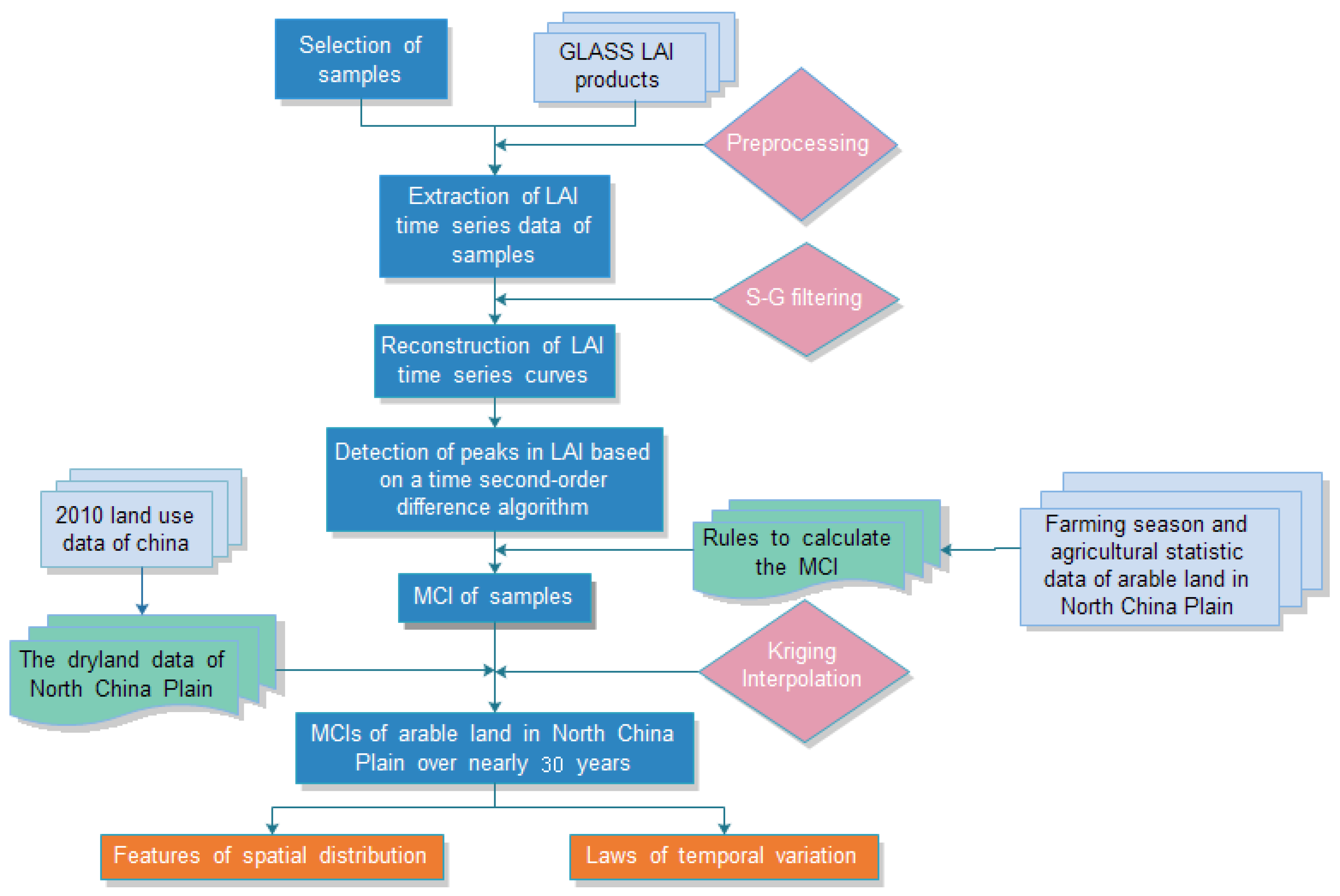
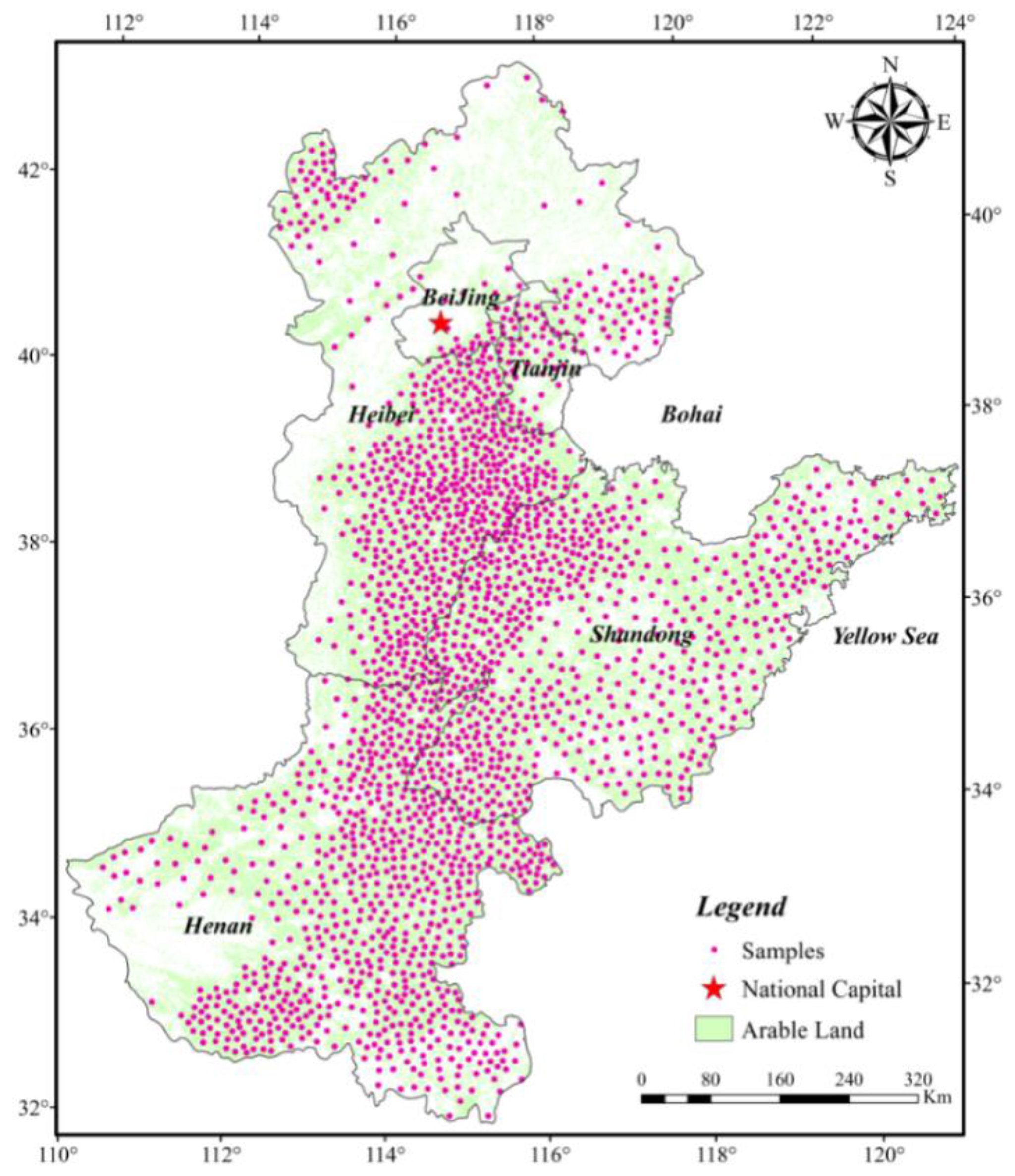
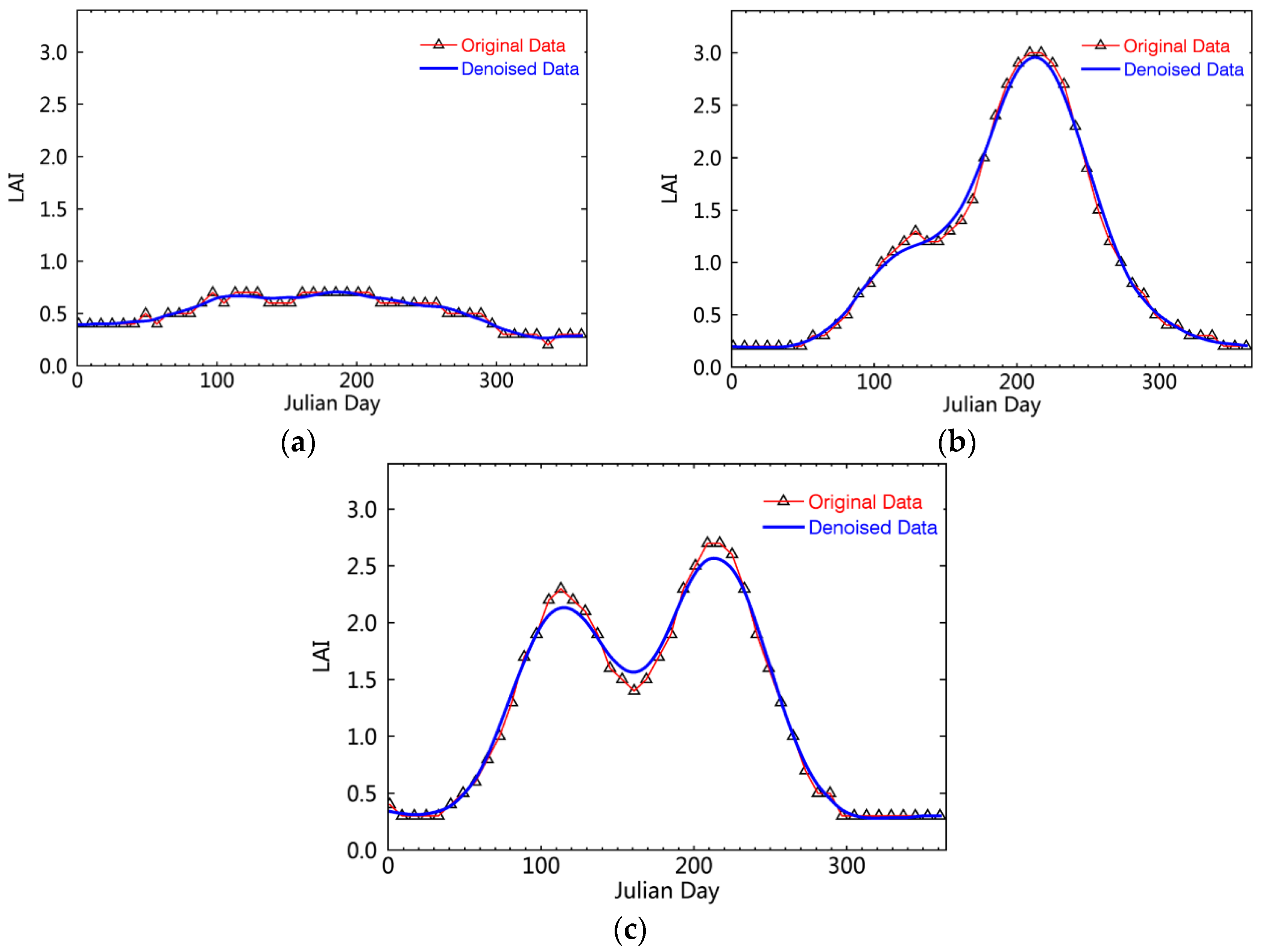
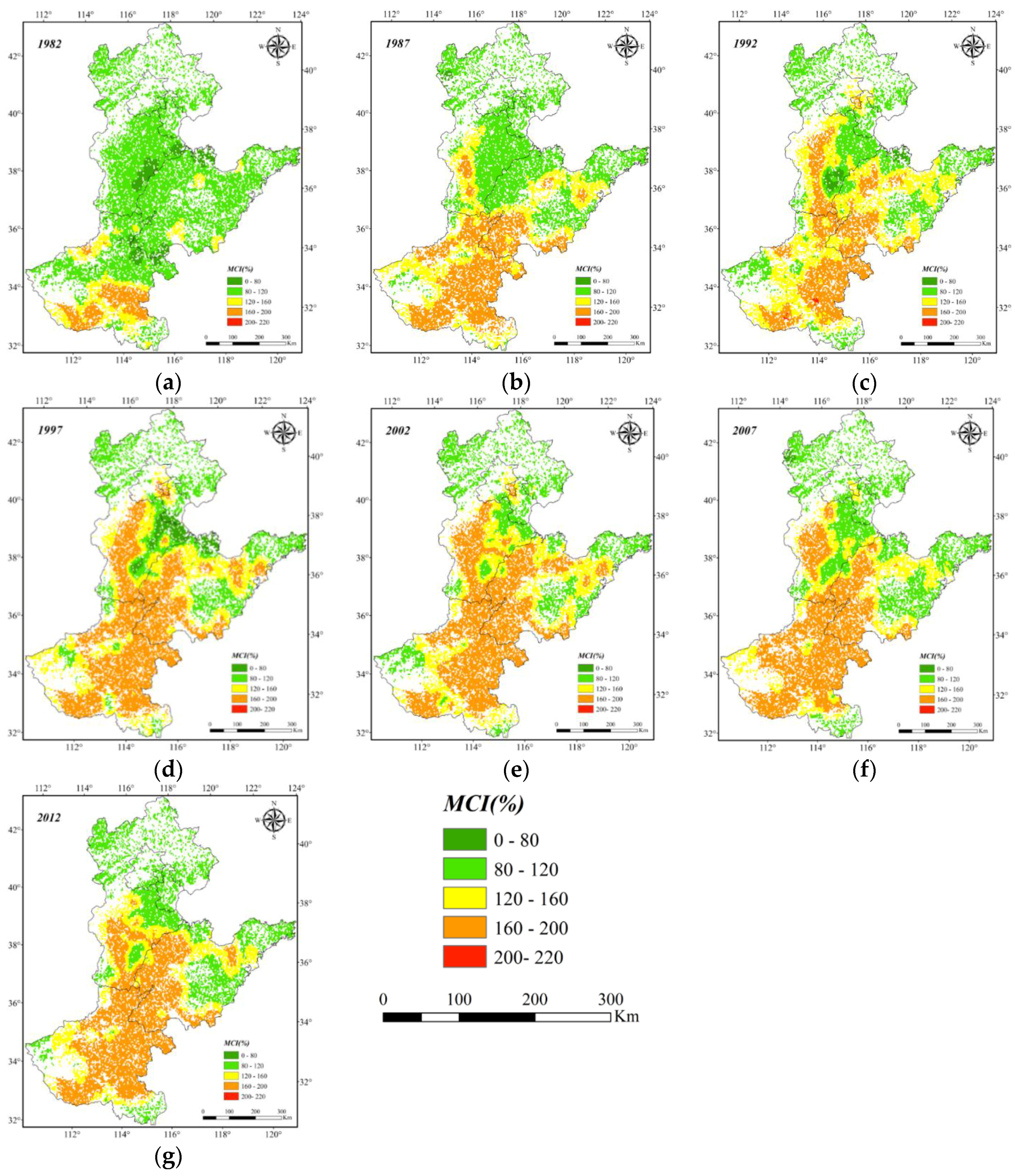
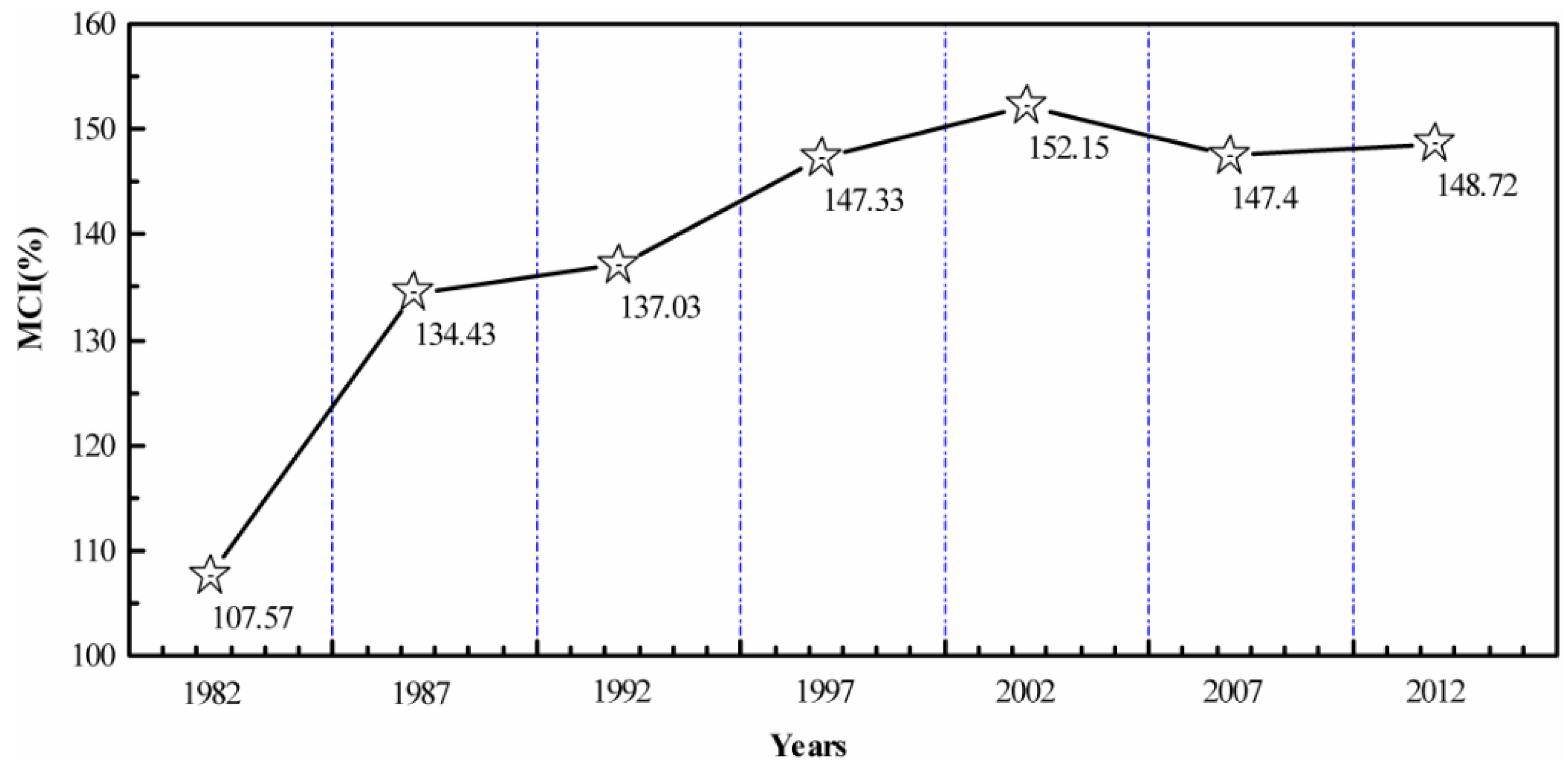
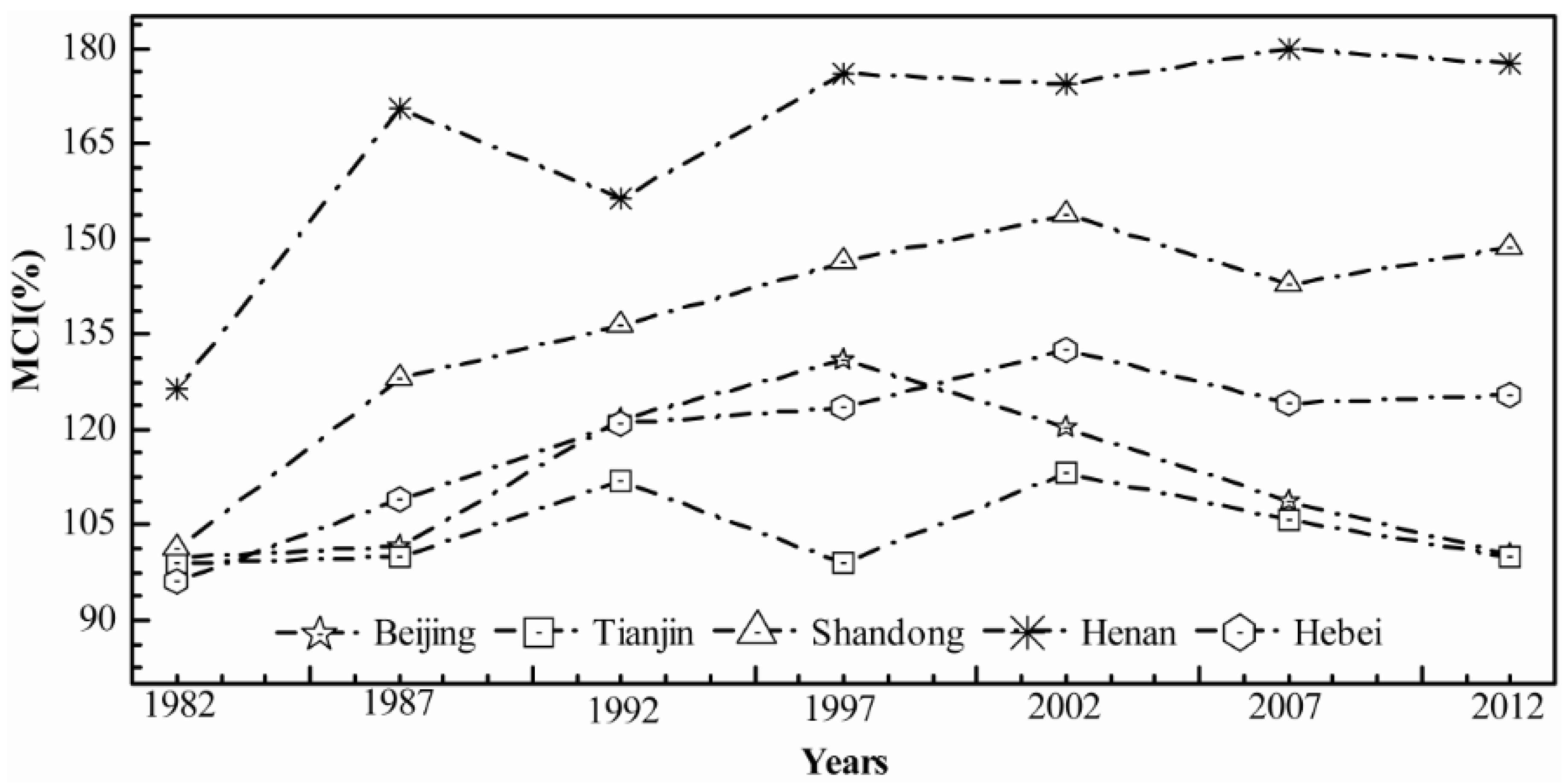
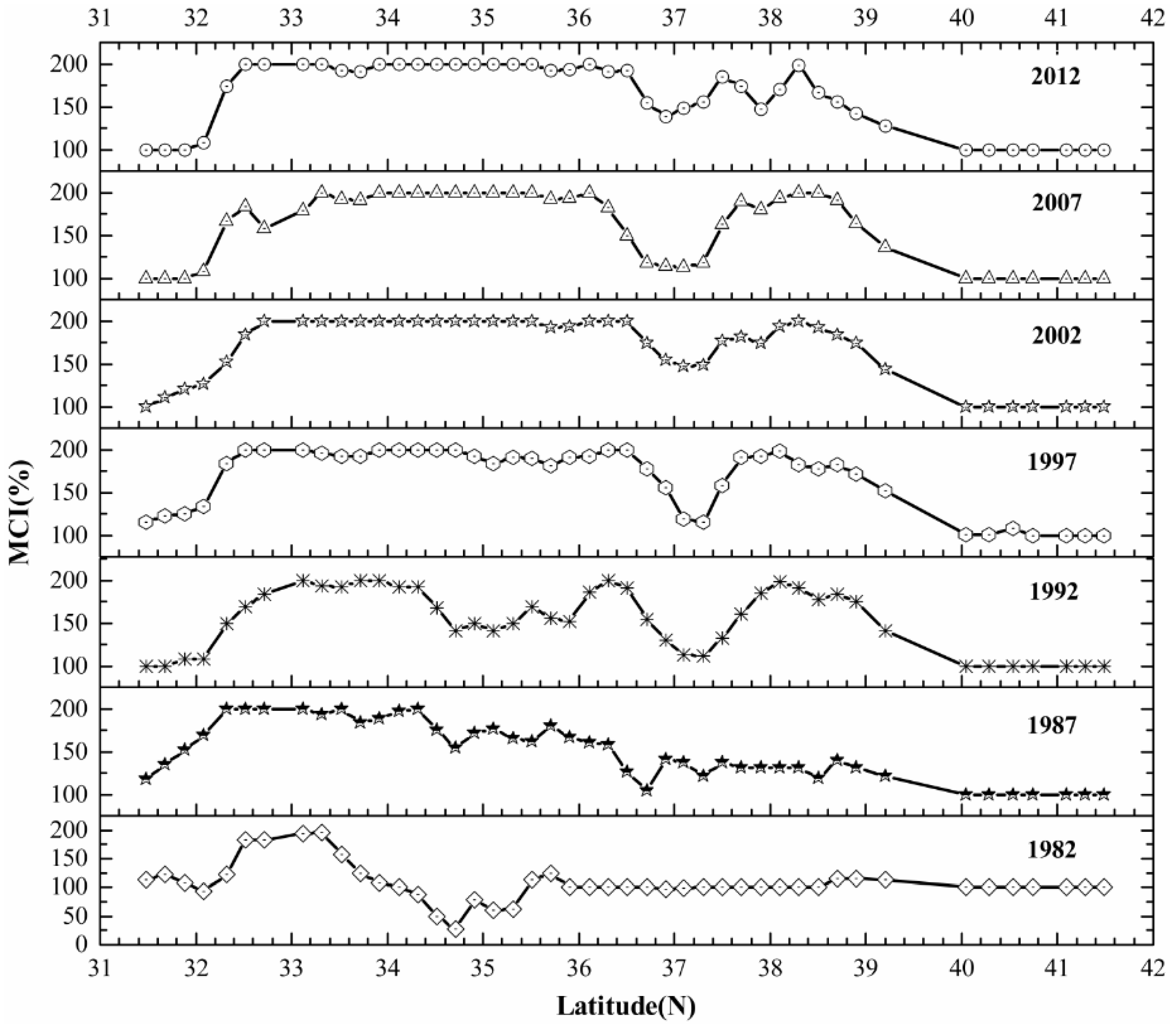

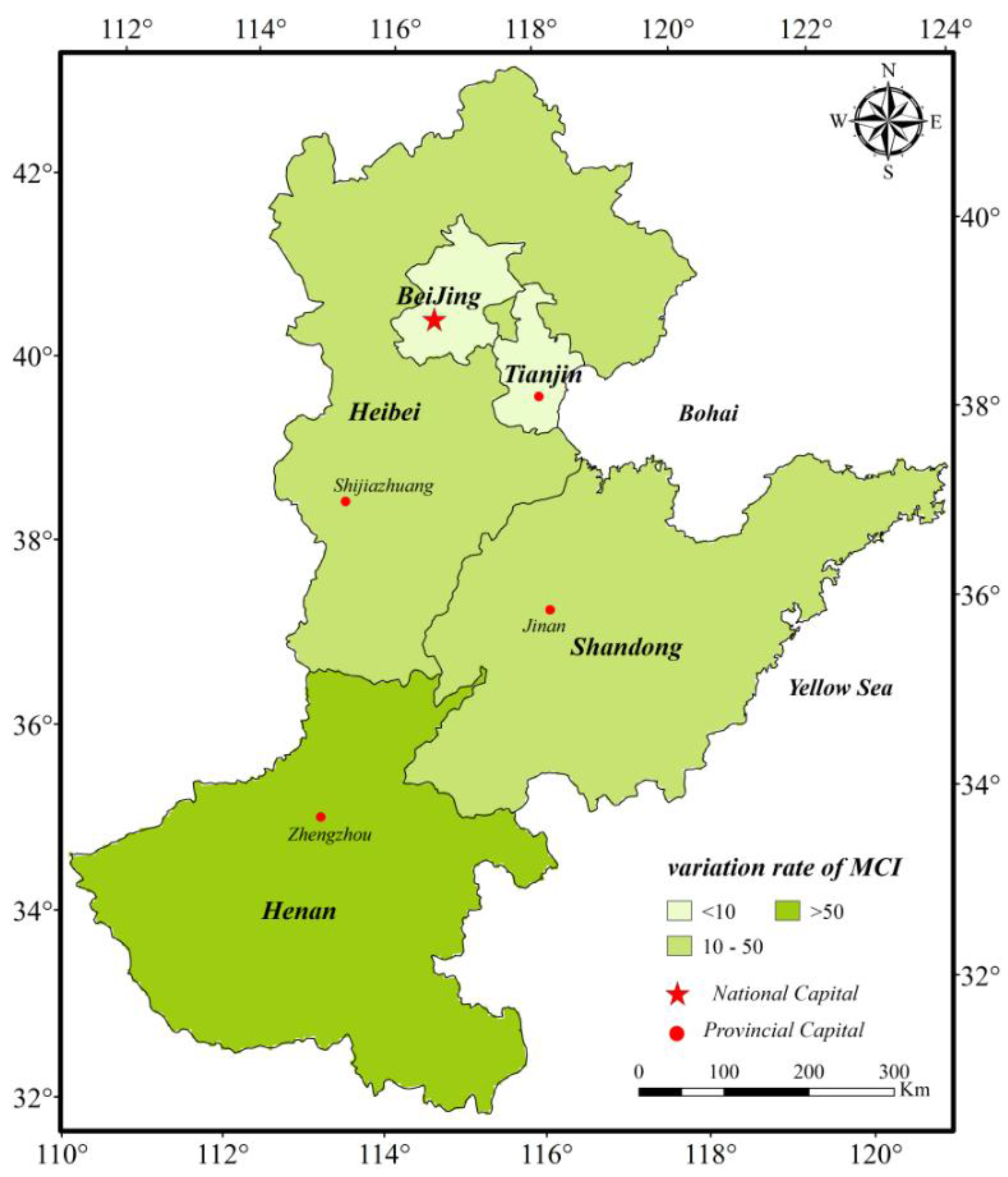
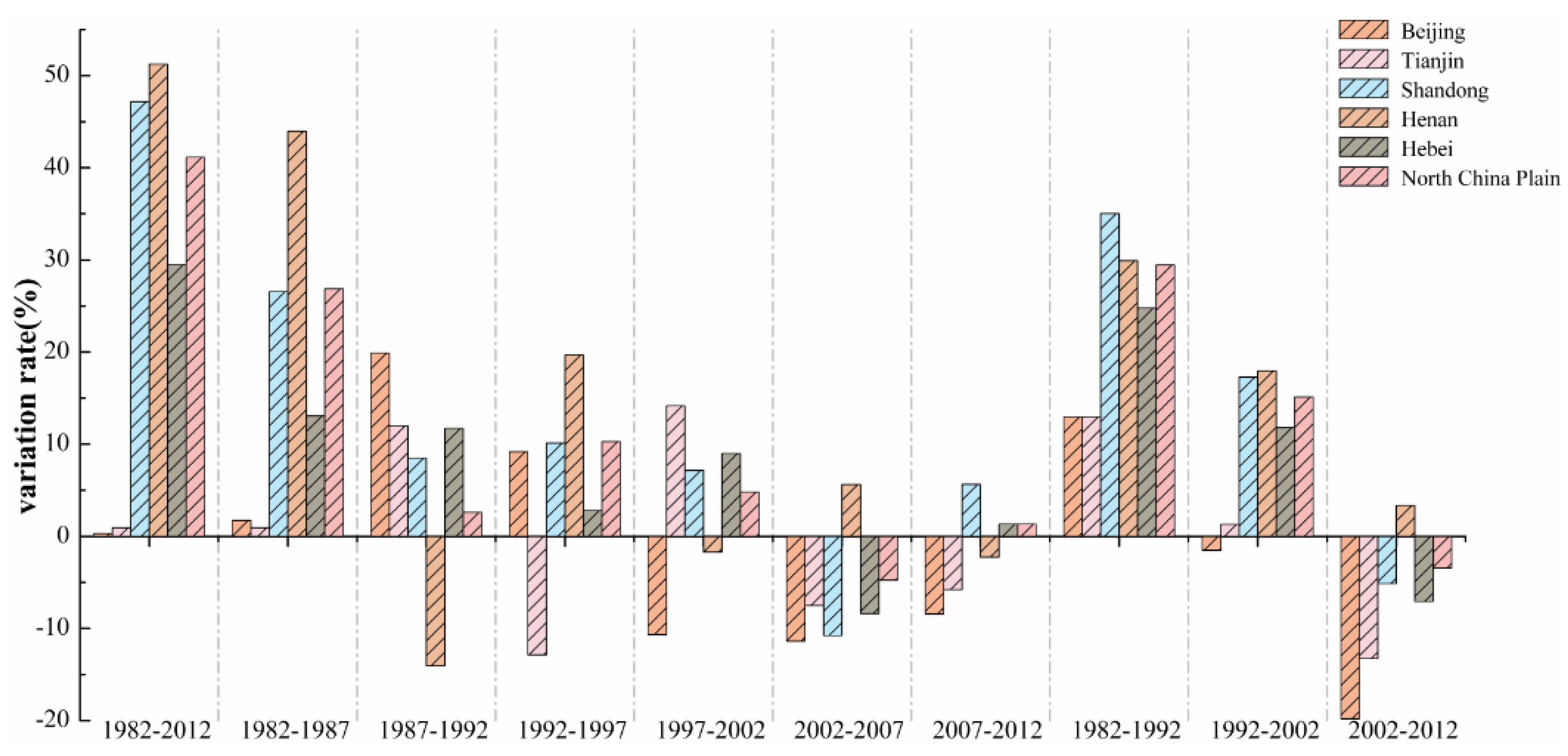


| Year | Beijing City | Tianjin City | Shandong Province | Henan Province | Hebei Province | NCP |
|---|---|---|---|---|---|---|
| 1982 | 100.00 | 99.05 | 101.35 | 126.44 | 96.06 | 107.57 |
| 1987 | 101.72 | 100.00 | 127.90 | 170.42 | 109.12 | 134.43 |
| 1992 | 121.63 | 111.99 | 136.38 | 156.36 | 120.84 | 137.03 |
| 1997 | 130.80 | 99.14 | 146.49 | 176.06 | 123.64 | 147.33 |
| 2002 | 120.12 | 113.29 | 153.65 | 174.33 | 132.63 | 152.15 |
| 2007 | 108.75 | 105.79 | 142.88 | 179.95 | 124.24 | 147.40 |
| 2012 | 100.32 | 100.00 | 148.53 | 177.69 | 125.57 | 148.72 |
| Average | 111.91 | 104.18 | 136.74 | 165.89 | 118.87 | 139.23 |
| Year | Term | Beijing City | Tianjin City | Hebei Province | Shandong Province | Henan Province |
|---|---|---|---|---|---|---|
| 1982 | Statistical Data | 151.46 | -- | 134.86 | 145.10 | -- |
| Extracted Data | 100.00 | 99.05 | 96.06 | 101.35 | 126.44 | |
| Accuracy * | 66.02% | -- | 71.23% | 70.46% | -- | |
| 1987 | Statistical Data | 123.07 | 110.82 | 120.14 | 140.24 | 171.43 |
| Extracted Data | 101.72 | 100.00 | 109.12 | 127.90 | 170.42 | |
| Accuracy | 82.65% | 90.24% | 90.83% | 91.20% | 99.41% | |
| 1992 | Statistical Data | 143.18 | 133.52 | 130.97 | 159.43 | 173.31 |
| Extracted Data | 121.63 | 111.99 | 120.84 | 136.38 | 156.36 | |
| Accuracy | 84.95% | 83.88% | 92.26% | 85.54% | 90.22% | |
| 1997 | Statistical Data | 134.12 | 123.63 | 135.90 | 164.03 | 180.41 |
| Extracted Data | 130.80 | 99.14 | 123.64 | 146.49 | 176.06 | |
| Accuracy | 97.53% | 80.19% | 90.98% | 89.31% | 97.59% | |
| 2002 | Statistical Data | 99.45 | 107.66 | 129.81 | 143.68 | 164.73 |
| Extracted Data | 120.12 | 113.29 | 132.63 | 153.65 | 174.33 | |
| Accuracy | 82.79% | 95.03% | 97.87% | 93.51% | 94.49% | |
| 2007 | Statistical Data | 127.05 | 97.81 | 137.02 | 142.86 | 177.74 |
| Extracted Data | 108.75 | 105.79 | 124.24 | 142.88 | 179.95 | |
| Accuracy | 85.60% | 92.46% | 90.68% | 99.98% | 98.77% | |
| 2012 | Statistical Data | 122.44 | 108.59 | 139.01 | 144.60 | 179.93 |
| Extracted Data | 100.32 | 100.00 | 125.57 | 148.53 | 177.69 | |
| Accuracy | 81.93% | 92.09% | 90.33% | 97.35% | 98.75% |
| Terms | Beijing City | Tianjin City | Shandong Province | Henan Province | Hebei Province | Derived from |
|---|---|---|---|---|---|---|
| MCIs (%) | 120.12 | 113.29 | 153.65 | 174.33 | 132.63 | This study (2002) |
| Other results | 113.4 | 128.2 | 165.3 | 194 | 153.5 | Fan et al., (2002) [10] |
| Difference value | 6.72 | −14.91 | −11.65 | −19.67 | −20.87 | |
| MCIs (%) | 108.75 | 105.79 | 142.88 | 179.95 | 124.24 | this study (2007) |
| Other results | 117.8 | 125 | 169 | 179.4 | 145.1 | Tang et al., (2007) [12] |
| Difference value | −9.05 | −19.21 | −26.12 | 0.55 | −20.86 | |
| MCIs (%) | 100.32 | 100 | 148.53 | 177.69 | 125.57 | This study (2012) |
| Other results | 124.5 | 110.6 | 147.6 | 184.3 | 138.6 | Xie et al., (2012) [47] |
| Difference value | −24.18 | −10.6 | 0.93 | −6.61 | −13.03 |
| Areas | Terms | 1992 | 1997 | 2002 | 2007 | Correlation Coefficient (R) |
|---|---|---|---|---|---|---|
| Beijing | Land fragmentation ** | 24.63 | 24.45 | 22.87 | 25.16 | 0.294 |
| City | Accuracy | 84.95 | 97.53 | 82.79 | 85.60 | |
| Tianjin | Land fragmentation | 17.25 | 18.86 | 18.10 | 17.81 | 0.268 |
| City | Accuracy | 83.88 | 80.19 | 95.03 | 92.46 | |
| Shandong | Land fragmentation | 23.08 | 24.11 | 22.09 | 23.11 | −0.263 |
| Province | Accuracy | 85.54 | 89.31 | 93.51 | 99.98 | |
| Henan | Land fragmentation | 15.68 | 15.63 | 15.45 | 15.64 | −0.066 |
| Province | Accuracy | 90.22 | 97.59 | 94.49 | 98.77 | |
| Hebei | Land fragmentation | 18.50 | 19.01 | 18.76 | 18.58 | 0.042 |
| Province | Accuracy | 92.26 | 90.98 | 97.87 | 90.68 |
© 2016 by the authors; licensee MDPI, Basel, Switzerland. This article is an open access article distributed under the terms and conditions of the Creative Commons Attribution (CC-BY) license (http://creativecommons.org/licenses/by/4.0/).
Share and Cite
Zhao, Y.; Bai, L.; Feng, J.; Lin, X.; Wang, L.; Xu, L.; Ran, Q.; Wang, K. Spatial and Temporal Distribution of Multiple Cropping Indices in the North China Plain Using a Long Remote Sensing Data Time Series. Sensors 2016, 16, 557. https://doi.org/10.3390/s16040557
Zhao Y, Bai L, Feng J, Lin X, Wang L, Xu L, Ran Q, Wang K. Spatial and Temporal Distribution of Multiple Cropping Indices in the North China Plain Using a Long Remote Sensing Data Time Series. Sensors. 2016; 16(4):557. https://doi.org/10.3390/s16040557
Chicago/Turabian StyleZhao, Yan, Linyan Bai, Jianzhong Feng, Xiaosong Lin, Li Wang, Lijun Xu, Qiyun Ran, and Kui Wang. 2016. "Spatial and Temporal Distribution of Multiple Cropping Indices in the North China Plain Using a Long Remote Sensing Data Time Series" Sensors 16, no. 4: 557. https://doi.org/10.3390/s16040557





